A Method for Predicting Transformer Oil-Dissolved Gas Concentration Based on Multi-Window Stepwise Decomposition with HP-SSA-VMD-LSTM
Abstract
1. Introduction
2. Fundamental Principle
2.1. Stepwise Decomposition Sampling (SDS)
2.2. HSV Sequence Decomposition Framework
2.2.1. Hodrick Prescott Filter (HP)
2.2.2. Singular Spectrum Analysis (SSA)
2.2.3. Variational Mode Decomposition (VMD)
2.3. Long Short-Term Memory Network (LSTM)
3. Dissolved Gas Concentration Prediction Model in Oil
4. Experimental Results and Analysis
4.1. Experiment I
4.1.1. HP Decomposition
4.1.2. SSA Decomposition
4.1.3. VMD Decomposition
4.1.4. LSTM Prediction
4.1.5. Analysis of Results
4.2. Experiment II
Analysis of Results
5. Conclusions
- (1)
- In the prediction of dissolved gases in transformer oil, the SDS strategy effectively mitigates the data leakage issue inherent to the ODS technique. The proposed HSV sequence decomposition framework in this study proves to be more compatible with SDS than traditional modal decomposition methods.
- (2)
- The selection of the decomposition window affects the extraction of long-term trends and periodic components. DE can improve the decomposition of long-term trends, while FE enhances the decomposition of periodic components. By utilizing DE and FE, optimal windows for extracting long-term trends and periodic features can be determined, thereby improving the accuracy of temporal feature extraction and reducing overall prediction difficulty.
- (3)
- Compared to traditional models, the predictive advantage of the proposed model in multi-step forecasting is more significant than in one-step forecasting.
Author Contributions
Funding
Data Availability Statement
Conflicts of Interest
Appendix A
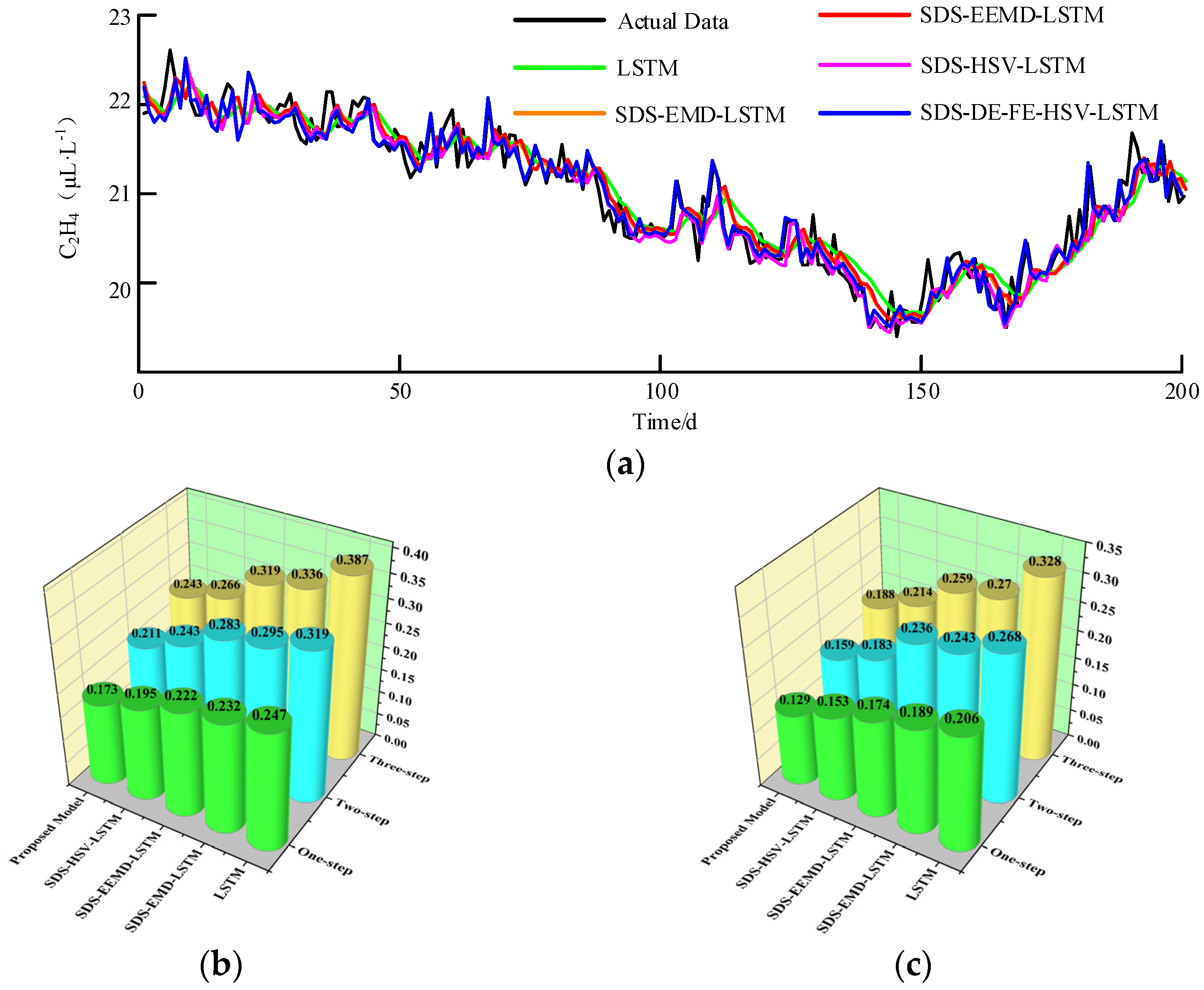
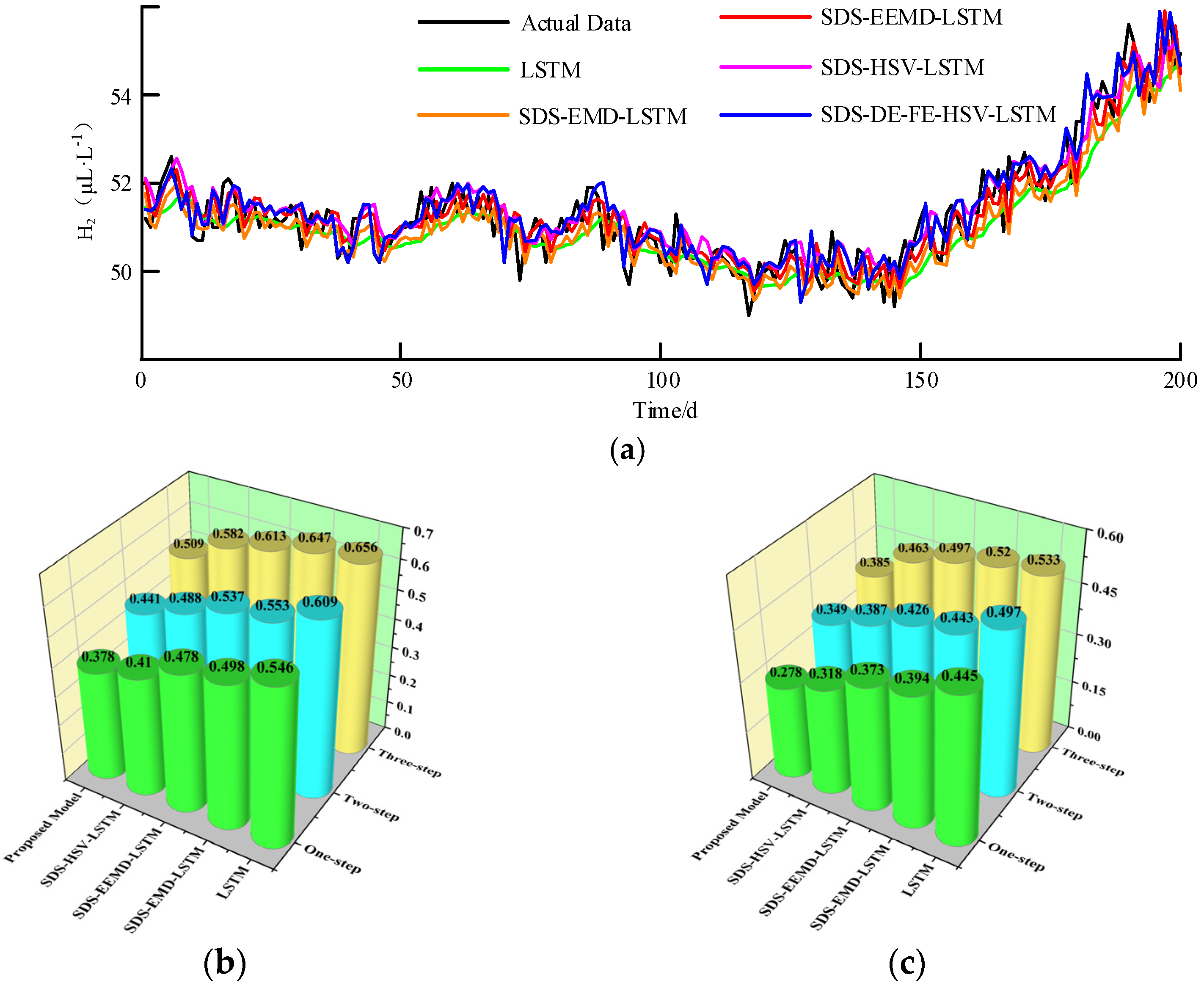
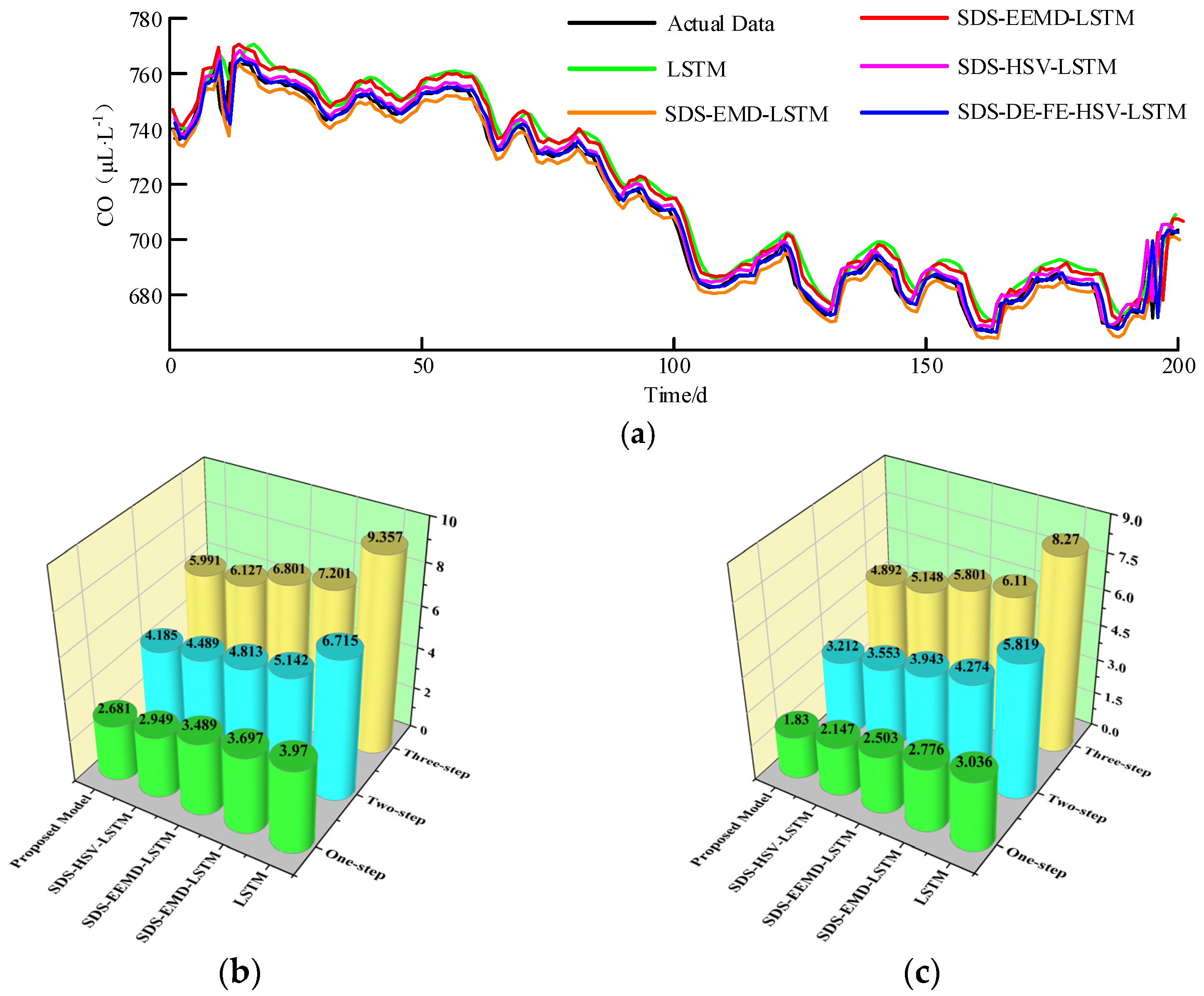
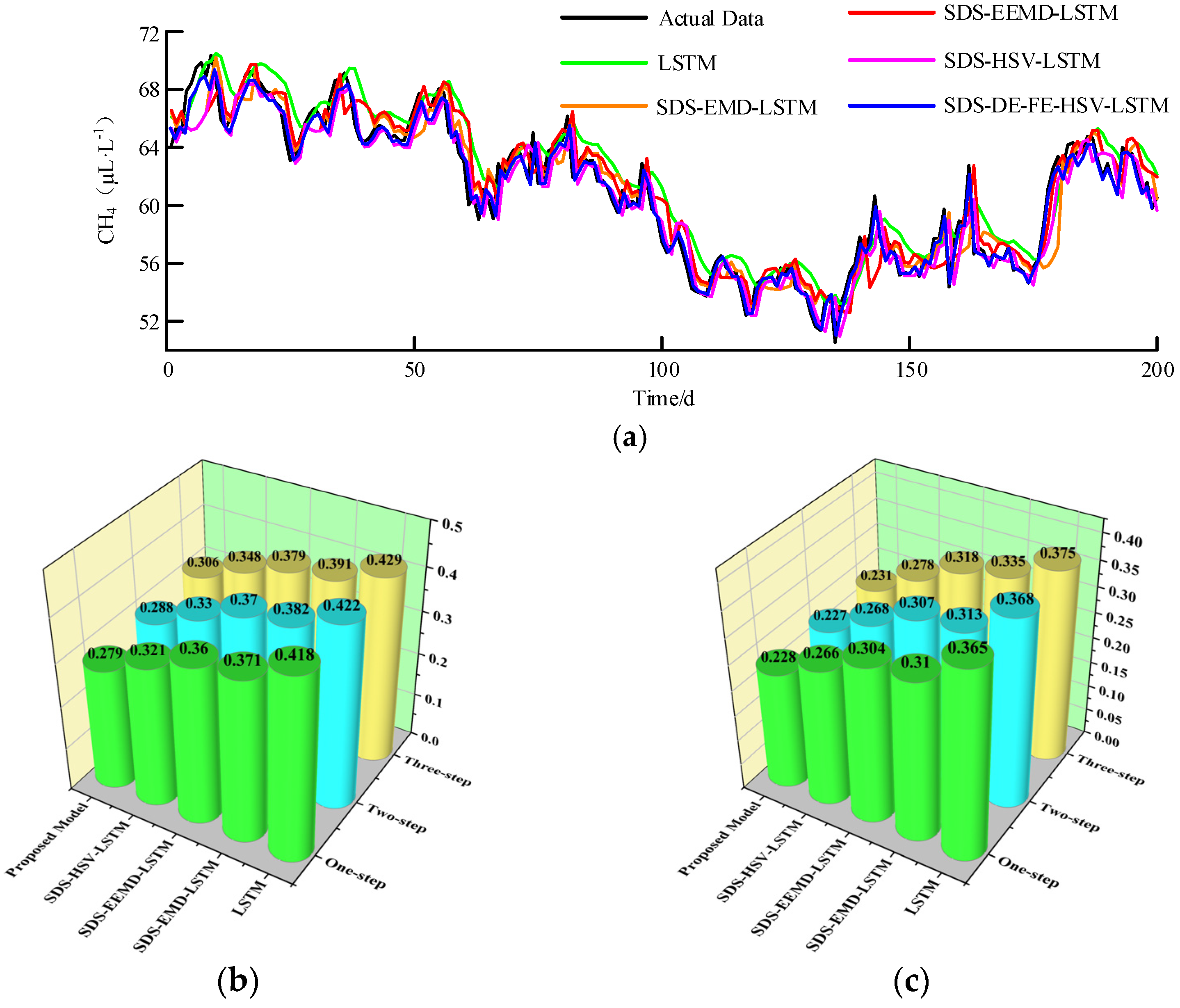
References
- A Guide to Transformer Oil Analysis. Available online: https://www.satcs.co.za/Transformer_Oil_Analysis.pdf (accessed on 18 December 2023).
- Wang, Y.; Li, W.; Zhao, H.S.; Zhang, J.L.; Shen, Z.W. Transformer DGA fault diagnosis method based on DBN-SSAELM. Power Syst. Prot. Control 2023, 51, 32–42. [Google Scholar]
- Xie, L.; Qiu, W.; Li, Z.; Liu, Y.; Jiang, Q.; Liu, D. Prediction model of dissolved gas in transformer oil based on variational modal decomposition and recurrent neural network with gated recurrent unit. High Volt. Eng. 2022, 48, 653–660. [Google Scholar]
- Mirowski, P.; Lecun, Y. Statistical machine learning and dissolved gas analysis: A review. IEEE Trans. Power Deliv. 2012, 27, 1791–1799. [Google Scholar] [CrossRef]
- Chen, T.; Leng, H.W.; Li, X.S.; Chen, Y.F. Transformer hierarchical fault diagnosis model based on dissolved gas analysis of insulating oil and class overlap features. Electr. Power 2022, 55, 22–32, 41. [Google Scholar]
- Gao, Q.; Dai, J.C.; Yuan, F.; Pan, F.H.; Li, Z.L. An On-Line monitoring device for dissolved gas in transformer oil based on spectrum technology. In Proceedings of the Earth and Environmental Science, Seoul, Republic of Korea,, 26–28 January 2019. [Google Scholar]
- Chen, Y.; Wang, Z.T.; Li, Z.; Zheng, H.Q.; Dai, J.M. Development of an online detection setup for dissolved gas in transformer insulating oil. Appl. Sci. 2021, 11, 12149. [Google Scholar] [CrossRef]
- Zai, H.T.; Chen, W.G.; He, H.Y.; Lee, W.J.; Zhang, Z.Y.; Zhang, K.; Fang, J.; Luo, D.S. Prediction for dissolved gas in power transformer oil based on temporal convolutional and graph convolutional network. In Proceedings of the 2021 IEEE/IAS Industrial and Commercial Power System Asia, Chengdu, China, 18–21 July 2021. [Google Scholar]
- Hu, C.; Zhong, Y.; Lu, Y.Q.; Luo, X.T.; Wang, S.R. A prediction model for time series of dissolved gas content in transformer oil based on LSTM. J. Phys. Conf. Ser. 2020, 1659, 012030. [Google Scholar] [CrossRef]
- Lin, J.; Su, L.; Yan, Y.J.; Sheng, G.H.; Xie, D.; Jiang, X.C. Prediction method for power transformer running state based on LSTM-DBN network. Energies 2018, 11, 1880. [Google Scholar] [CrossRef]
- Ding, C.; Ding, Q.C.; Feng, L.; Wang, Z.L. Prediction model of dissolved gas in transformer oil based on VMD-SMA-LSSVM. IEEJ Trans. Electr. Electron. Eng. 2022, 17, 1432–1440. [Google Scholar] [CrossRef]
- Zhang, P.; Qi, B.; Zhang, R.Y.; Shao, M.Y.; Li, C.R. Dissolved gas prediction in transformer oil based on empirical wavelet transform and gradient boosting radial basis. Power Syst. Technol. 2021, 45, 3745–3754. [Google Scholar]
- Liu, J.X.; Zhao, Z.J.; Zhong, Y.C.; Zhao, C.C.; Zhang, G.G. Prediction of the dissolved gas concentration in power transformer oil based on SARIMA model. In Proceedings of the 2021 the 2nd International Conference on Power Engineering, Nanning, China, 9–11 December 2021. [Google Scholar]
- Chen, Y.; He, Z.; Shang, Z.; Li, C.; Li, L.; Xu, M. A novel combined model based on echo state network for multi-step ahead wind speed forecasting: A case study of NREL. Energy Convers. Manag. 2019, 179, 13–29. [Google Scholar] [CrossRef]
- Shen, Y.F.; Zheng, W.; Yin, W.J.; Xu, A.G.; Zhu, H.Z. Feature extraction algorithm using a correlation coefficient combined with the VMD and its application to the GPS and GRACE. IEEE Access 2021, 9, 17507–17519. [Google Scholar] [CrossRef]
- Teng, C.Y.; Ding, Y.C.; Zhang, Y.B.; Li, S.; Mo, Y.J. Ultra-short-term photovoltaic power prediction based on VMD-informer-BiLSTM mode. High Volt. Eng. 2023, 49, 2961–2971. [Google Scholar]
- Zeng, B.; Guo, J.; Zhang, F.Q.; Zhu, W.Q.; Xiao, Z.H.; Huang, S.X.; Fan, P. Prediction model for dissolved gas concentration in transformer oil based on modified grey wolf optimizer and LSSVM with grey relational analysis and empirical mode decomposition. Energies 2020, 13, 422. [Google Scholar] [CrossRef]
- Santhosh, M.; Venkaiah, C.; Vinod, K.D.M. Ensemble empirical mode decomposition based adaptive wavelet neural network method for wind speed prediction. Energy Convers. Manag. 2018, 168, 482–493. [Google Scholar] [CrossRef]
- Wang, Y.M.; Wu, L. On practical challenges of decomposition-based hybrid forecasting algorithms for wind speed and solar irradiation. Energy 2016, 112, 208–220. [Google Scholar] [CrossRef]
- Zheng, Q.; Yan, P.; Hamidreza, Z.; Chen, N.Y. A review and discussion of decomposition-based hybrid models for wind energy forecasting applications. Appl. Energy 2019, 235, 939–953. [Google Scholar]
- Fang, W.; Huang, S.Z.; Ren, K.; Huang, Q.; Huang, G.H.; Cheng, G.H.; Li, K.L. Examining the applicability of different sampling techniques in the development of decomposition-based streamflow forecasting models. J. Hydrol. 2019, 568, 534–550. [Google Scholar] [CrossRef]
- Jiang, Y.; Liu, S.; Zhao, N.; Xin, J.; Wu, B. Short-term wind speed prediction using time varying filter-based empirical mode decomposition and group method of data handling-based hybrid model. Energy Convers. Manag. 2020, 220, 113076. [Google Scholar] [CrossRef]
- Wang, T.; Zhang, M.C.; Yu, Q.H.; Zhang, H.Y. Comparing the applications of EMD and EEMD on time-frequency analysis of seismic signal. J. Appl. Geophys. 2012, 83, 29–34. [Google Scholar] [CrossRef]
- Hodrick, R.J.; Prescott, E.C. Postwar U.S. business cycles: An empirical investigation. J. Money Credit Bank. 1997, 29, 1–16. [Google Scholar] [CrossRef]
- Weron, R.; Zator, M. A note on using the Hodrick Prescott filter in electricity markets. Energy Econ. 2015, 48, 1–6. [Google Scholar] [CrossRef][Green Version]
- Tong, C.F.; Shi, H.B.; Bao, X.Q.; Li, H.P. Application of a combined model based on wavelet analysis for predicting crop water requirement. Trans. Chin. Soc. Agric. Eng. 2011, 27, 93–98. [Google Scholar]
- Zeng, Q.H.; Huang, L.; Liu, J.Y.; Chen, L.J.; Gu, S.S. Real-time filtering methods of FOG random noise based on ARMA model. J. Chin. Inert. Technol. 2015, 23, 120–124. [Google Scholar]
- Li, Z.Q.; Zhang, X.Y.; Tian, H.D. Prediction method of satellite telemetry data using HP filter. Spacecr. Eng. 2021, 30, 23–30. [Google Scholar]
- Wang, C.; Zhang, H.L.; Ma, P. Wind power forecasting based on singular spectrum analysis and a new hybrid laguerre neural network. Appl. Energy 2020, 259, 114139. [Google Scholar] [CrossRef]
- Moreno, S.R.; Coelho, L.D.S. Wind speed forecasting approach based on singular spectrum analysis and adaptive neuro fuzzy inference system. Renew. Energy 2018, 126, 736–754. [Google Scholar] [CrossRef]
- Dragomiretskiy, K.; Zosso, D. Variational mode decomposition. IEEE Trans. Signal Process. 2014, 62, 531–544. [Google Scholar] [CrossRef]
- Azami, H.; Arnold, S.E.; Sanei, S.; Chang, Z.Q.; Sapiro, G.; Escudero, J.; Gupta, A.S. Multiscale fluctuation-based dispersion entropy and its applications to neurological diseases. IEEE Access 2019, 7, 68718–68733. [Google Scholar] [CrossRef]
- Liao, W.Q.; Fu, W.L.; Yang, K.; Tan, C.; Huang, Y.G. Multi-scale residual neural network with enhanced gated recurrent unit for fault diagnosis of rolling bearing. Meas. Sci. Technol. 2024, 35, 056114. [Google Scholar] [CrossRef]
- Chen, W.T.; Wang, Z.Z.; Xie, H.B.; Yu, W.X. Characterization of surface EMG signal based on fuzzy entropy. IEEE Trans. Neural Syst. Rehabil. Eng. 2007, 15, 266–272. [Google Scholar] [CrossRef]
- Agga, A.; Abbou, A.; Labbadi, M.; Houm, Y.E.; Ali, I.H.O. CNN-LSTM: An efficient hybrid deep learning architecture for predicting short-term photovoltaic power production. Electr. Power Syst. Res. 2022, 208, 107908. [Google Scholar] [CrossRef]
- Aziz, W.; Arif, M. Multiscale permutation entropy of physiological time series. In Proceedings of the 2005 Pakistan Section Multitopic Conference, Karachi, Pakistan, 24–25 December 2005. [Google Scholar]
- Feng, H.W.; Ji, H.X.; Zhi, F.H.; Xu, G. Stock price prediction based on SSA and SVM. Procedia Comput. Sci. 2014, 31, 625–631. [Google Scholar] [CrossRef]
- Lu, T.D.; Xie, J.X. Deformation monitoring data de-noising method based on variational mode decomposition combined with sample entropy. J. Geod. Geodyn. 2021, 41, 1–6. [Google Scholar]
- Morabito, F.C.; Labate, D.; Foresta, F.L.; Bramanti, A.; Morabito, G.; Palamara, I. Multivariate multi-scale permutation entropy for complexity analysis of Alzheimer’s disease EEG. Entropy 2012, 14, 1186–1202. [Google Scholar] [CrossRef]
- Xue, J.K.; Shen, B. A novel swarm intelligence optimization approach: Sparrow search algorithm. Syst. Sci. Control Eng. 2020, 8, 22–34. [Google Scholar] [CrossRef]







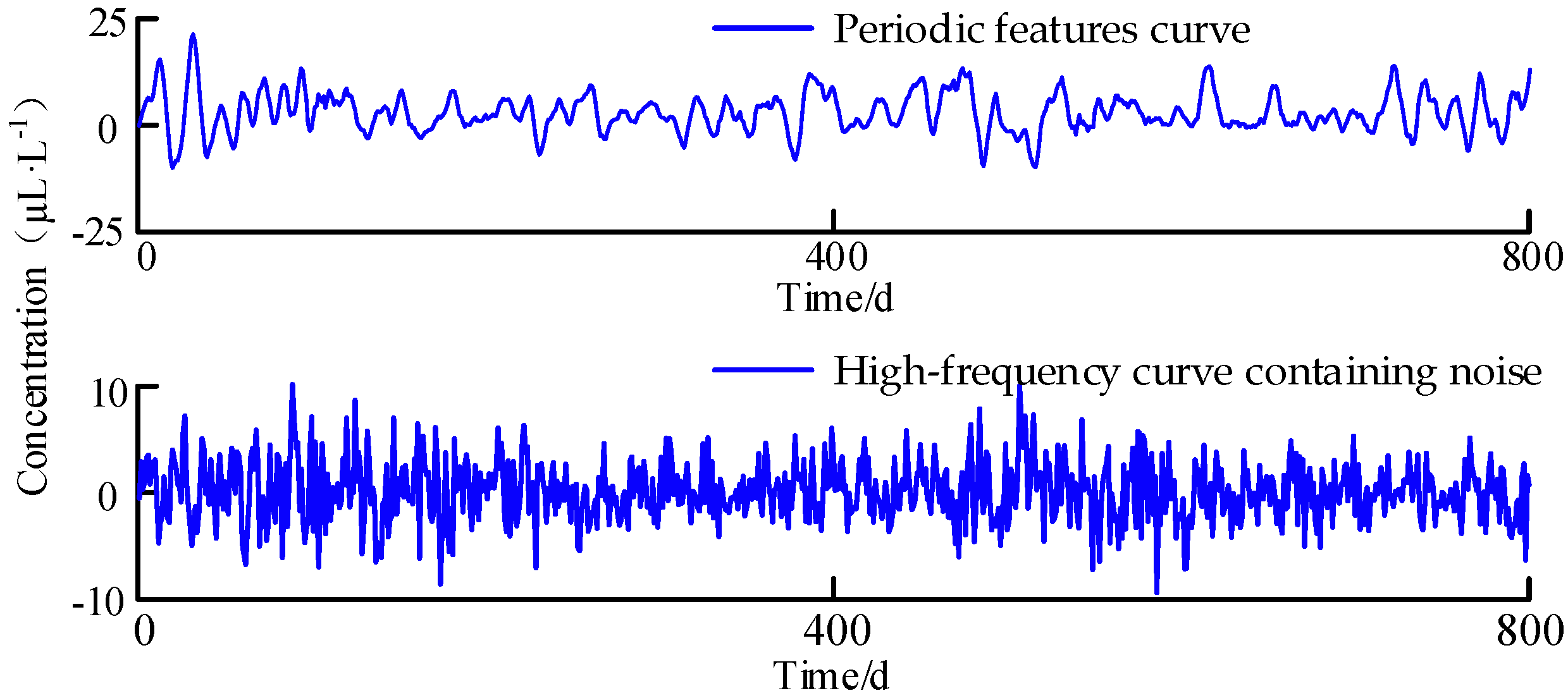
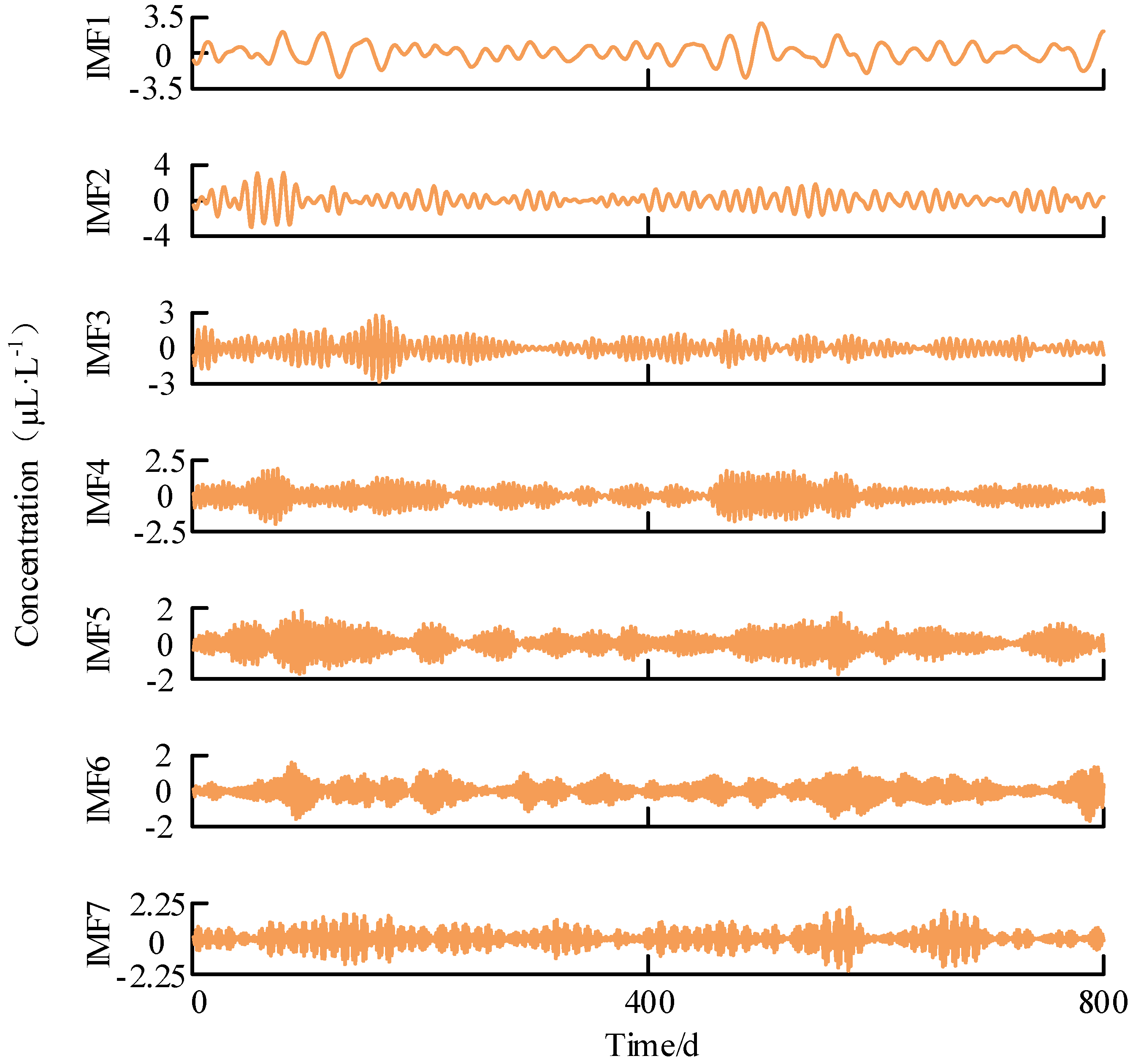
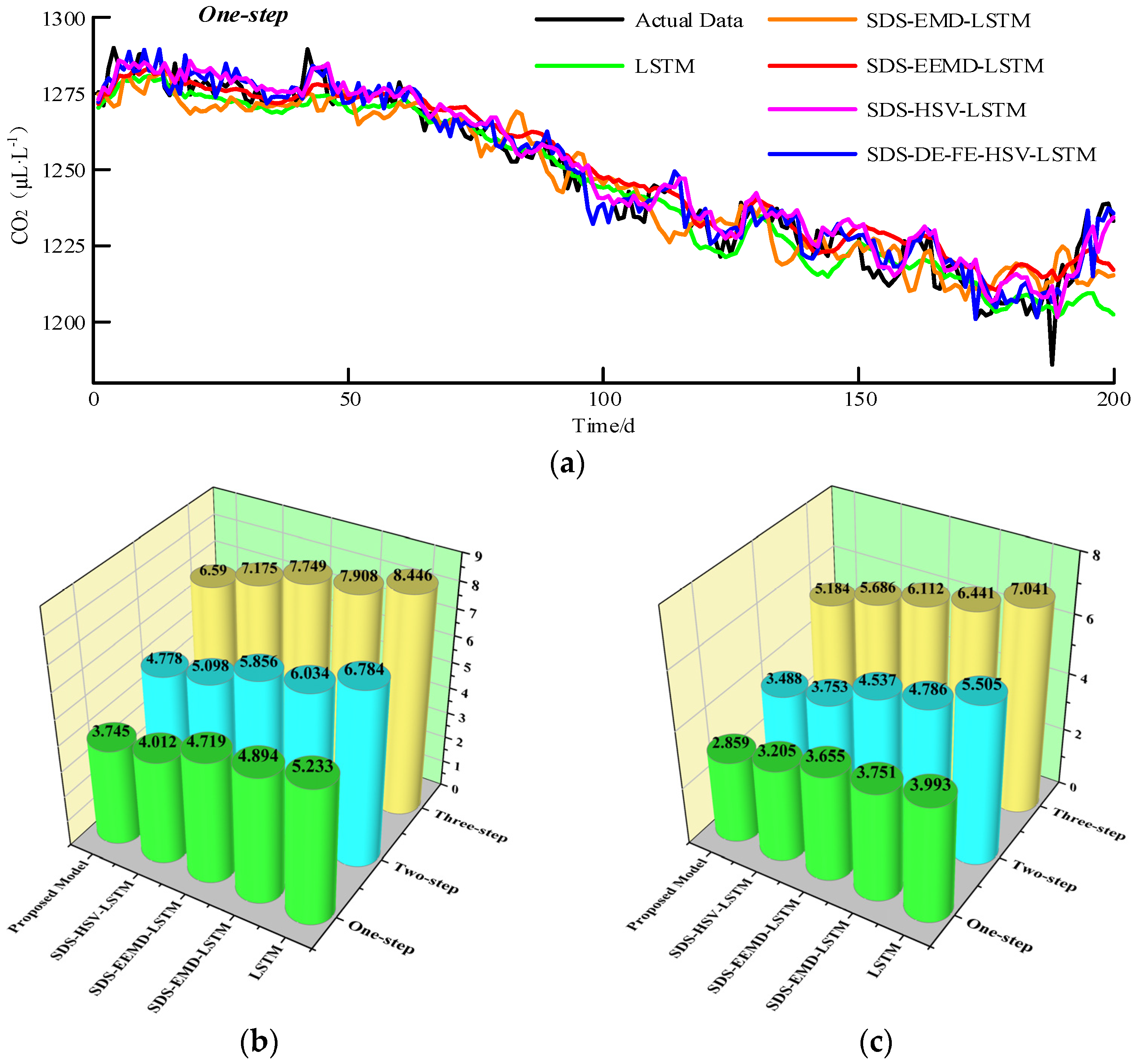

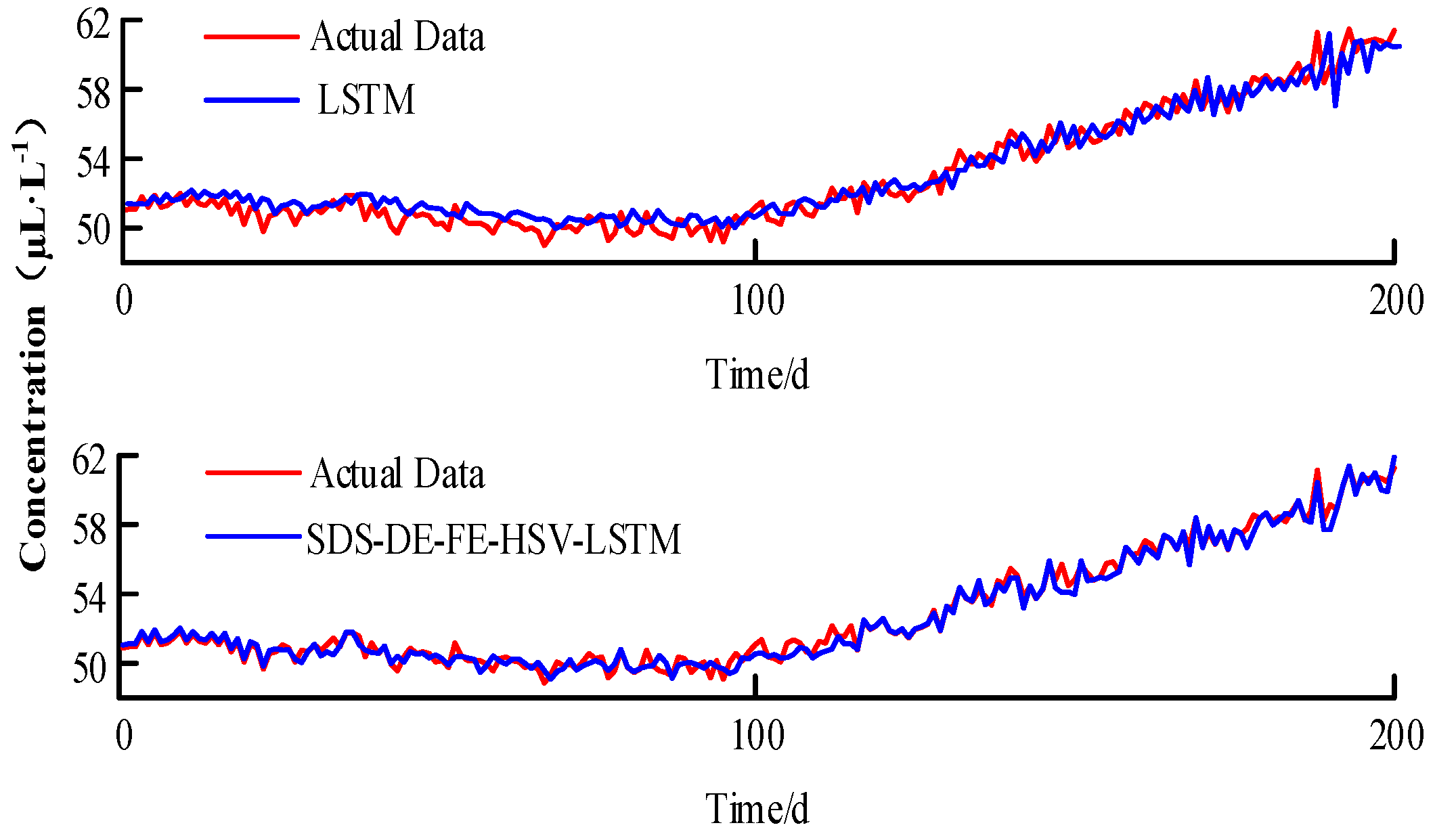
| Metrics | Definition | Equations |
|---|---|---|
| RMSE | Root mean square error | |
| MAE | Mean absolute error |
| Modal components | IMF1 | IMF2 | IMF3 | IMF4 | IMF5 | IMF6 | IMF7 |
| MPE | 0.3758 | 0.4805 | 0.6755 | 0.6702 | 0.6817 | 0.6672 | 0.6901 |
| Model Parameters | Long-Term Trend | Periodic Feature | Low-Frequency Mode Component |
|---|---|---|---|
| learning rate | 0.01 | 0.01 | 0.02 |
| iterations | 143 | 35 | 124 |
| neurons | 50 | 60 | 52 |
| Gases | Models | One-Step | Two-Step | THREE-STEP | |||
|---|---|---|---|---|---|---|---|
| RMSE | MAE | RMSE | MAE | RMSE | MAE | ||
| CO2 | LSTM | 5.233 | 3.993 | 6.784 | 5.505 | 8.446 | 7.041 |
| SDS-EMD-LSTM | 4.894 | 3.751 | 6.034 | 4.786 | 7.908 | 6.441 | |
| SDS-EEMD-LSTM | 4.719 | 3.655 | 5.856 | 4.537 | 7.749 | 6.112 | |
| SDS-HSV-LSTM | 4.012 | 3.205 | 5.098 | 3.753 | 7.175 | 5.686 | |
| SDS-DE-FE-HSV-LSTM | 3.745 | 2.859 | 4.778 | 3.488 | 6.590 | 5.184 | |
| CH4 | LSTM | 0.418 | 0.365 | 0.422 | 0.368 | 0.429 | 0.375 |
| SDS-EMD-LSTM | 0.371 | 0.310 | 0.382 | 0.313 | 0.391 | 0.335 | |
| SDS-EEMD-LSTM | 0.360 | 0.304 | 0.370 | 0.307 | 0.379 | 0.318 | |
| SDS-HSV-LSTM | 0.321 | 0.266 | 0.330 | 0.268 | 0.348 | 0.278 | |
| SDS-DE-FE-HSV-LSTM | 0.279 | 0.228 | 0.288 | 0.227 | 0.306 | 0.231 | |
| C2H4 | LSTM | 0.247 | 0.206 | 0.319 | 0.268 | 0.387 | 0.328 |
| SDS-EMD-LSTM | 0.232 | 0.189 | 0.295 | 0.243 | 0.336 | 0.270 | |
| SDS-EEMD-LSTM | 0.222 | 0.174 | 0.283 | 0.236 | 0.319 | 0.259 | |
| SDS-HSV-LSTM | 0.195 | 0.153 | 0.243 | 0.183 | 0.266 | 0.214 | |
| SDS-DE-FE-HSV-LSTM | 0.173 | 0.129 | 0.211 | 0.159 | 0.243 | 0.188 | |
| CO | LSTM | 3.970 | 3.036 | 6.715 | 5.819 | 9.357 | 8.270 |
| SDS-EMD-LSTM | 3.697 | 2.776 | 5.142 | 4.274 | 7.201 | 6.110 | |
| SDS-EEMD-LSTM | 3.489 | 2.503 | 4.813 | 3.943 | 6.801 | 5.801 | |
| SDS-HSV-LSTM | 2.949 | 2.147 | 4.489 | 3.553 | 6.127 | 5.148 | |
| SDS-DE-FE-HSV-LSTM | 2.681 | 1.830 | 4.185 | 3.212 | 5.991 | 4.892 | |
| H2 | LSTM | 0.546 | 0.445 | 0.609 | 0.497 | 0.656 | 0.533 |
| SDS-EMD-LSTM | 0.498 | 0.394 | 0.553 | 0.443 | 0.647 | 0.520 | |
| SDS-EEMD-LSTM | 0.478 | 0.373 | 0.537 | 0.426 | 0.613 | 0.497 | |
| SDS-HSV-LSTM | 0.410 | 0.318 | 0.488 | 0.387 | 0.582 | 0.463 | |
| SDS-DE-FE-HSV-LSTM | 0.378 | 0.278 | 0.441 | 0.349 | 0.509 | 0.385 | |
| Gases | Models | RMSE | MAE |
|---|---|---|---|
| H2 | LSTM | 0.703 | 0.573 |
| SDS-DE-FE-HSV-LSTM | 0.408 | 0.303 | |
| CH4 | LSTM | 0.867 | 0.732 |
| SDS-DE-FE-HSV-LSTM | 0.367 | 0.301 | |
| CO | LSTM | 6.213 | 4.951 |
| SDS-DE-FE-HSV-LSTM | 3.466 | 1.905 |
Disclaimer/Publisher’s Note: The statements, opinions and data contained in all publications are solely those of the individual author(s) and contributor(s) and not of MDPI and/or the editor(s). MDPI and/or the editor(s) disclaim responsibility for any injury to people or property resulting from any ideas, methods, instructions or products referred to in the content. |
© 2024 by the authors. Licensee MDPI, Basel, Switzerland. This article is an open access article distributed under the terms and conditions of the Creative Commons Attribution (CC BY) license (https://creativecommons.org/licenses/by/4.0/).
Share and Cite
Chen, T.; Guo, S.; Zhang, Z.; Yuan, Y.; Gao, J. A Method for Predicting Transformer Oil-Dissolved Gas Concentration Based on Multi-Window Stepwise Decomposition with HP-SSA-VMD-LSTM. Electronics 2024, 13, 2881. https://doi.org/10.3390/electronics13142881
Chen T, Guo S, Zhang Z, Yuan Y, Gao J. A Method for Predicting Transformer Oil-Dissolved Gas Concentration Based on Multi-Window Stepwise Decomposition with HP-SSA-VMD-LSTM. Electronics. 2024; 13(14):2881. https://doi.org/10.3390/electronics13142881
Chicago/Turabian StyleChen, Tie, Shinan Guo, Zhifan Zhang, Yimin Yuan, and Jiaqi Gao. 2024. "A Method for Predicting Transformer Oil-Dissolved Gas Concentration Based on Multi-Window Stepwise Decomposition with HP-SSA-VMD-LSTM" Electronics 13, no. 14: 2881. https://doi.org/10.3390/electronics13142881
APA StyleChen, T., Guo, S., Zhang, Z., Yuan, Y., & Gao, J. (2024). A Method for Predicting Transformer Oil-Dissolved Gas Concentration Based on Multi-Window Stepwise Decomposition with HP-SSA-VMD-LSTM. Electronics, 13(14), 2881. https://doi.org/10.3390/electronics13142881






